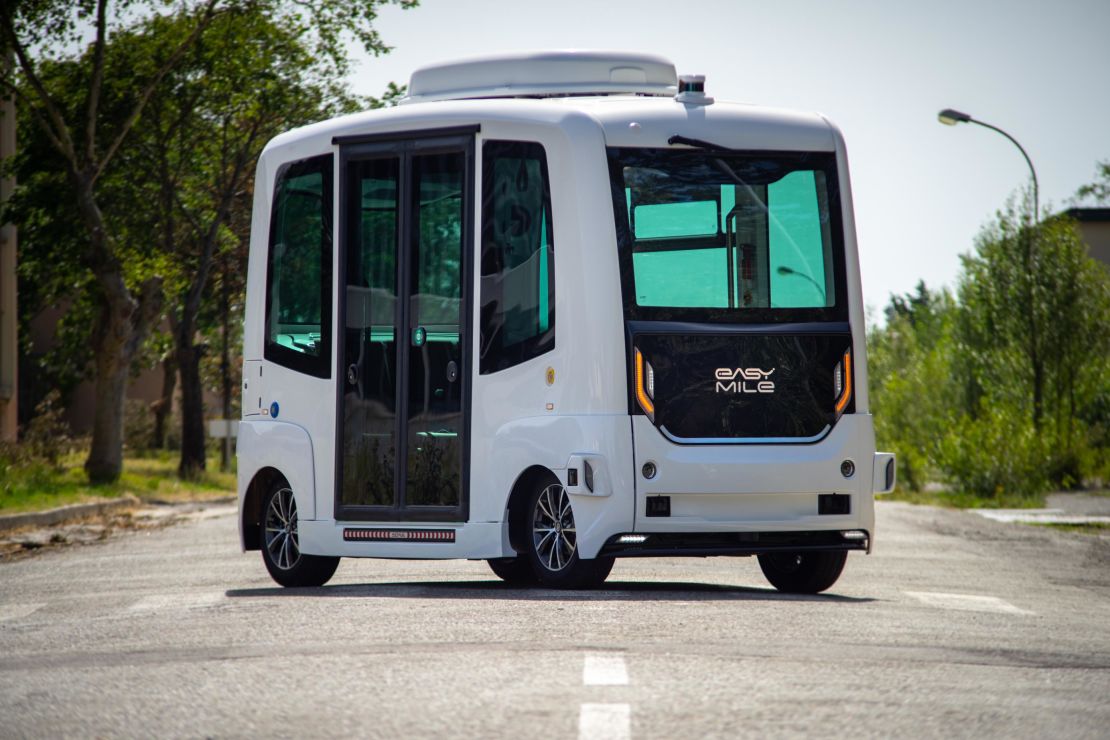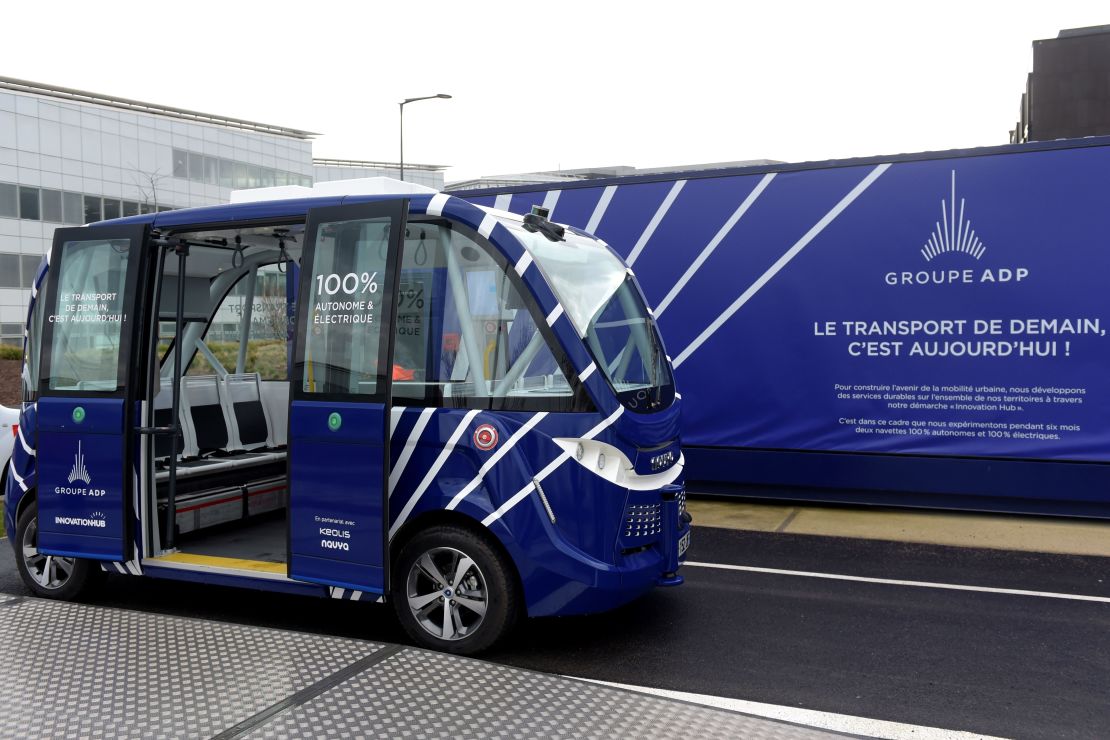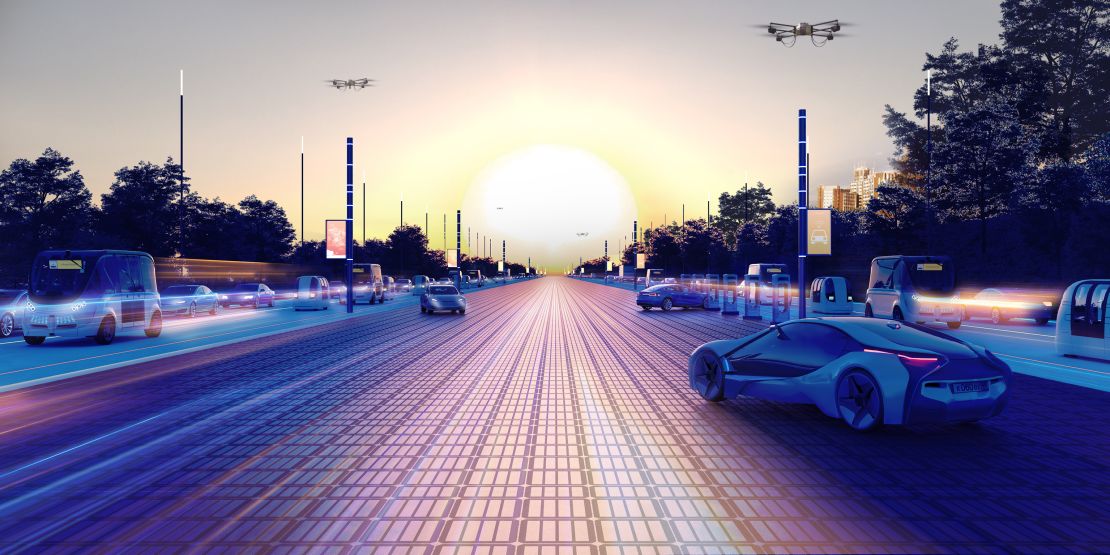The NEXT Future Transportation module is a far cry from the sleek visions of self-driving cars designed by Tesla or Mercedes.
With an average cruising speed of 20 kilometers per hour, the electric pods are unlikely to set pulses racing.
But perhaps the most crucial distinction is that this self-driving vehicle is passenger ready.
Following trials in 2018, several NEXT units are expected to be in action at the Expo 2020 site in Dubai, providing short-distance rides for some of the estimated 25 million visitors attending the six-month world fair.
The Ruler of Dubai, Sheikh Mohammed bin Rashid Al Maktoum, has set the demanding target of having 25% of journeys in the city to be made through driverless transport by 2030 – going beyond the existing driverless metro and monorail systems.
Separately, the city has also set a target of increasing the share of journeys taken by public transport and shared mobility (including taxis) to 26% by the same year.
It is hoped that such advances can reduce the city’s carbon footprint and the number of traffic accidents, as well as enhancing its reputation as a capital of advanced technology.
The autonomous pods from NEXT and similar designs could play a key role in realizing these ambitions.
Slow and steady
The inaugural Self-Driving Congress in Dubai took place in October, drawing many of the leading manufacturers and experts from around the world.
The centerpiece of the event was a challenge in the category of First and Last-Mile Connections, for pod-style vehicles providing links to and from transport hubs, venues, and within communities, with more than $5 million in prize money at stake.
The attraction of this mode of transport is that the technology is proven, although the use cases are limited, says Ahmed Bahrozyan, CEO of the Public Transport Agency at Dubai’s Roads and Transport Authority (RTA).
“We feel with these shuttle buses the technology is quite mature,” Bahrozyan told CNN. “They only go up to 20-30 kilometers per hour so are quite difficult to integrate with normal traffic but they have proved they are useful in more confined cases such as university campuses.”
Dubai is not the first city to experiment with this mode of transport.
Self-driving shuttles have been operating in the US, France, and Switzerland since 2016. Pod vehicles have also been deployed for elderly passengers in Australia and schoolchildren in the US.
Proof of concept
The companies producing pods believe their vehicle can serve both practical and psychological purposes.
French firm Easy Mile, a finalist at the Self-Driving Congress, has tested its models across the US, Europe, and Asia. It has also been operating its EZ10 vehicle in Dubai’s “Sustainable City” complex – a “living laboratory” for low-carbon technologies – over the past year.
Easy Mile’s Middle East head Tarek Bouallegui says the slower pods offer value compared to more advanced alternatives due to the relative cost of sensors they use, which makes it easier for them to enter the market and demonstrate the technology.
“This is not technology where the vehicle will cost $5 million, which is the main reason people are paying attention to these types of pods,” says Bouallegui.

The low-speed shuttles also allow passengers to familiarize themselves with self-driving vehicles, he adds, in a less frightening environment than say, a high-performance sports car.
Bouallegui also sees the pod as a supplement to existing transport networks, and as particularly suited to Dubai.
“If I need to walk 800 meters to a metro station in Dubai there is a good chance I would not do it because of the heat – I would take a car,” he says. “Our pods would act as a feeder to existing mass transit solutions that operate on wider distances with higher capacities.”
Pod vehicles might also improve efficiency on Dubai’s busiest commuter routes.
NEXT’s modules can connect and communicate with each other – allowing for several to be combined into a single unit with maximum space efficiency – which could play a role in reducing traffic congestion.
“Even if there is just one unit moving at a slow speed it can move 10-15 passengers within the the same length as a traditional sedan car,” says company co-founder Tommaso Gecchelin.
NEXT pods can also go faster on the open road with a top speed of 90 kilometers per hour.
Laying the foundations
While private companies develop autonomous vehicles, the responsibility of a city is to provide the framework and infrastructure to accommodate them, says Bahrozyan.
He lists several of the challenges; “Do we have the legislation in place? Do we have the high resolution maps to allow vehicles to navigate the streets safely? How are we going to tackle cybersecurity with all these cars connected and the potential for hacking?”
Work is ongoing on all of the above challenges and many more, including the ambition to connect self-driving cars with traffic lights so users know when the colors will change.
The RTA is also exploring more audacious transport modes beyond the pod-style vehicles.
Bahrozyan says that autonomous air taxis, first tested in 2017, could enter public service “in the next few years” and offer a solution to traffic congestion.
“There are some issues with the battery not advancing as fast as the technology of the vehicle itself so range is still an issue,” he says. “If the air taxis can’t fly long distances the use cases are limited.”
The RTA’s roadmap to fulfilling its target for autonomous and public transport also includes larger buses, robotaxis, and even marine transport.
The global race
The UAE placed ninth in KPMG’s Autonomous Vehicles Readiness Index, but experts believe Dubai enjoys competitive advantages over other players in the global race.
“Dubai is very strong on technology…and well placed to reach its targets for autonomous vehicle use,” says KPMG’s Global Head of Infrastruture Finance Ravi Suri.
Suri says advances in Artificial Intelligence (AI) and 5G networks will improve the quality of autonomous navigation and communication between vehicles.

Bahrozyan also believes that regulatory “flexibility” will play a role in convincing leading companies that Dubai is a perfect environment to operate in.
“For us, it is a very important distinguishing factor that we have done many innovative projects in the past and proved we can turn around regulations very quickly,” he says.
Another advantage is Dubai’s desert climate. The sensors used in autonomous vehicles can struggle with heavy rain – hence the creation of Singapore’s “monsoon room” to test them in heavy weather. Such conditions are extremely rare in Dubai.
Stubborn obstacles
The field of autonomous transport still faces stubborn obstacles that have thwarted some of the more bullish predictions for their future.
There is the challenge of adaptation to different environments, such as rainy conditions.
Then there is the issue of coexistence between human and robotic drivers on the streets, which can lead to unanticipated safety risks.
“A self-driving vehicle with even a small amount of sensors can be 99% safer than a human driver,” says Gecchelin, noting the high proportion of crashes caused by human error.
“The problem is it’s too safe…if the sensor sees an unknown object and brakes immediately with full power that can be dangerous,” he says.

Some scientists and city planners are looking at entirely redesigning roads and cities to better accommodate autonomous vehicles.
MIT’s Senseable City Lab has presented visions such as a transformation of Parisian freeways with fewer lanes as traffic will be more efficient when automated, and lined with solar panels to charge electric vehicles.
Such grand ambitions may or may not be realized. For all the exhilarating potential of self-driving transport, much of it is yet to be fulfilled.
The more humble charms of short-distance pods are rarely celebrated. But they represent a small, tangible step towards the glittering future we were promised.



















